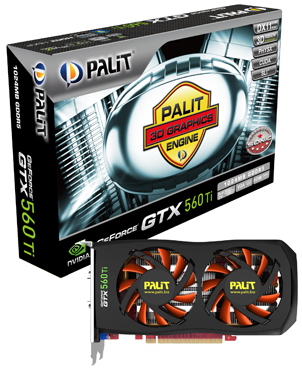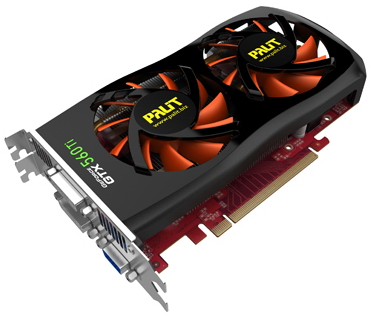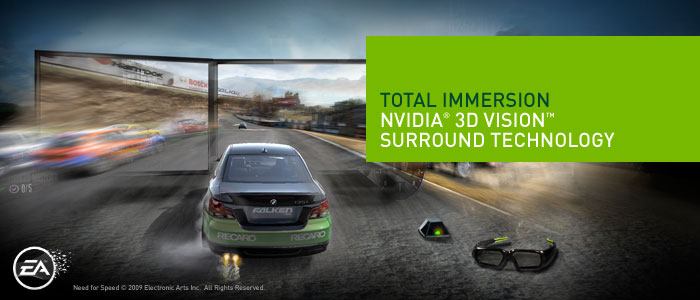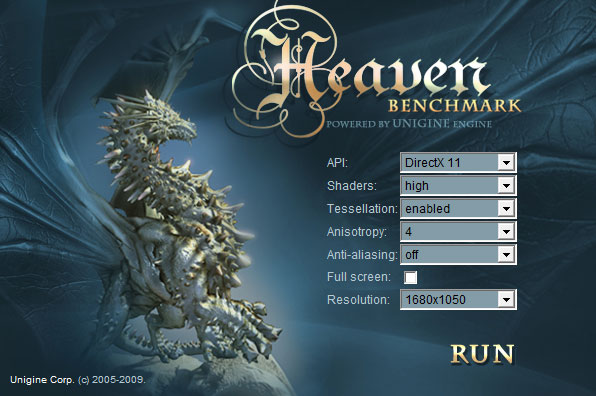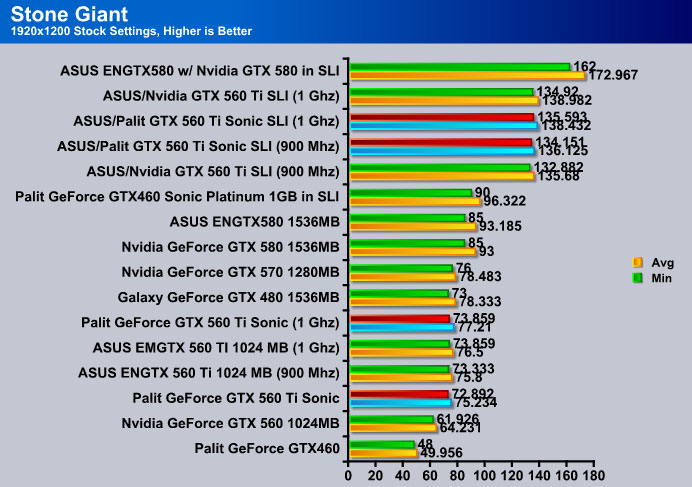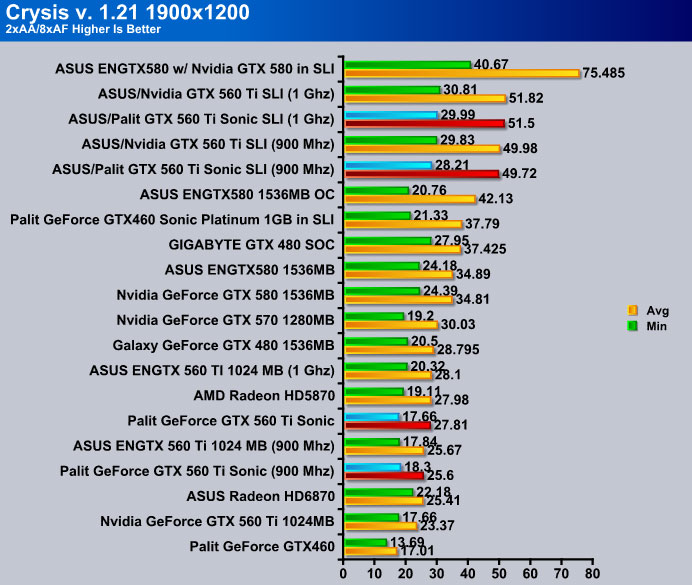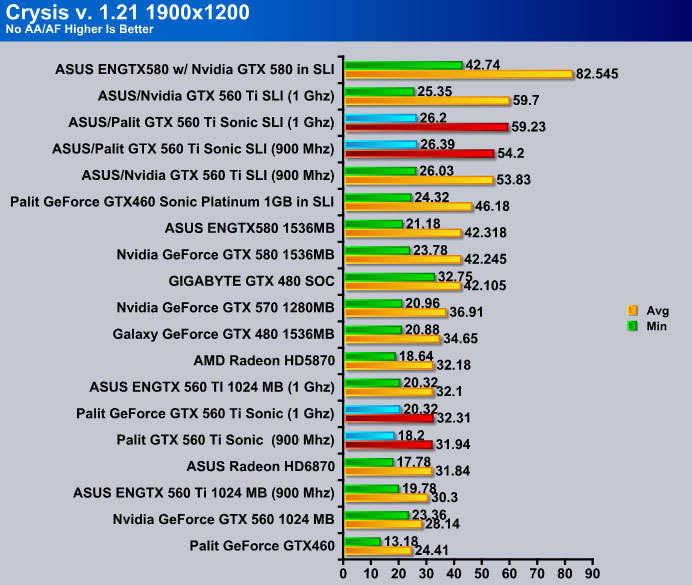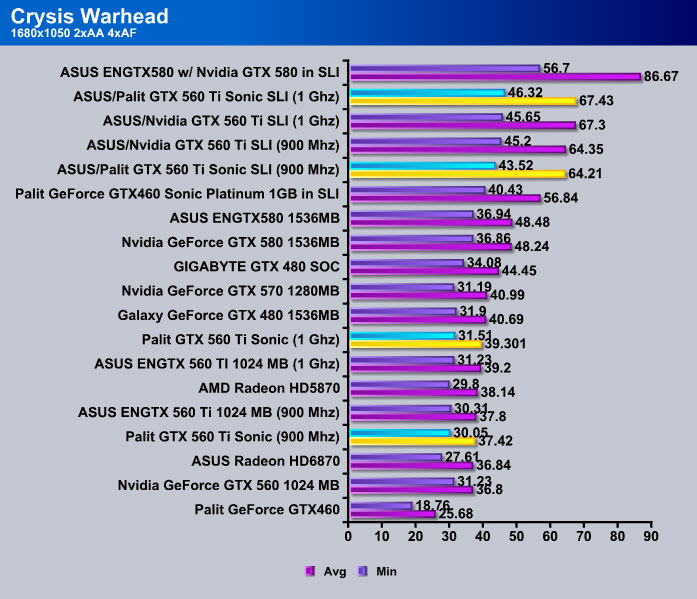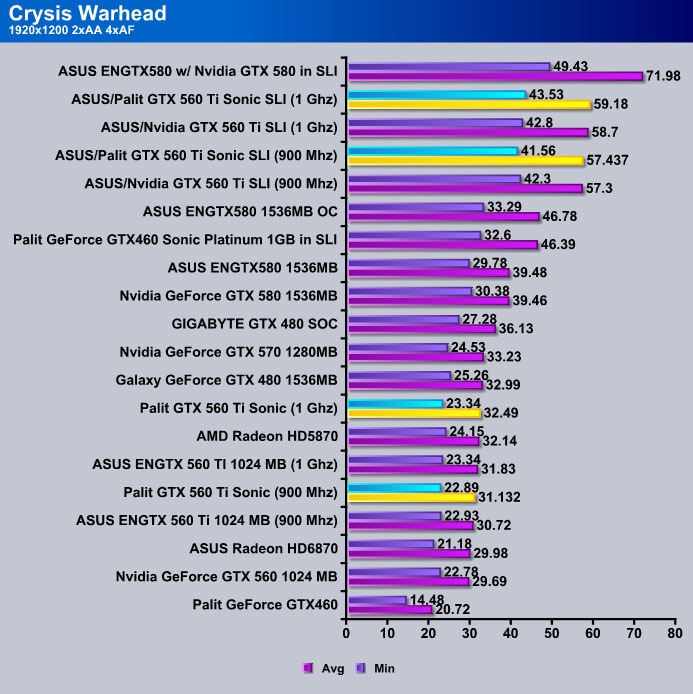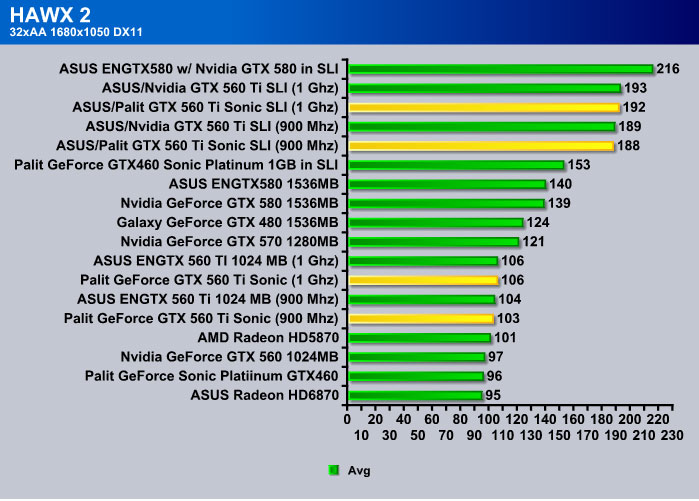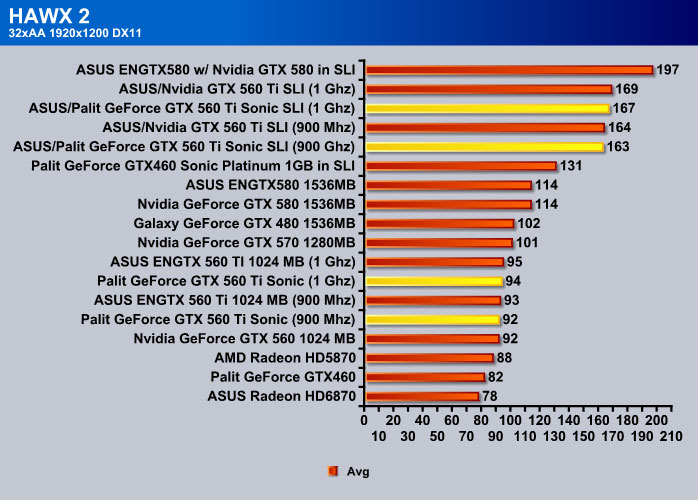Palit GTX 560 Ti Sonic delivers great performance worthy of its price. It is an ideal graphics card for any gaming enthusiast.
Introduction
Utilizing the newly optimized GF114 Fermi Architechture GPU, the GTX 560 Ti has demonstrated outstanding performance so far. While the stock GPU of the GTX 560 Ti is set to 822 MHz, new architechture allows for these lower-end high-performance cards to clock at frequencies of over 1 GHz, closely approaching the performance of the GTX 570 and GTX 480. However the most definitive feature of these cards is efficiency, showing the highest performance/watt out of all GeForce 500 series cards.
In order to accomodate the proper performance and cooling observed in GTX 560 Ti, several modifications have been done to the old GTX 460. The new GF114 has been equiped with 384 fully active CUDA cores, producing an overall 15-30% performance increase over GTX 460. The addition of extra raster engines and PolyMorph engines, made specifically for polygon tessellation and pixelation, provides an even more apparent performance increase in games utilizing DirectX 11. The modification in cooling and overall architechture of PCB have been targeted in order to ensure that the temperature of the GTX 560 Ti remains close to that of its predecessor. While the Nvidia reference card did demonstrate a change in addition of voltage chips on the back of GPU and capacitors in order to accomodate the increase in the overall voltage, the overall heat sink and fan design have been left up to the vendors.
The Palit GTX 560 Ti Sonic, clocked at 900 MHz, has been finely tuned to provide an ultimate gaming experience, while conserving the high performance/watt efficiency demonstrated in all GTX 560 Ti cards. Palit incorporated a dual 80mm fan design, and shrunk down the PCB by a few inches. This compact design makes the Palit GTX 560 Ti Sonic an ideal contender for any mid tower case, as well as lowering the overall voltage required to power the card. Currently, the Palit GTX 560 Ti Sonic is priced at 259.99 USD, while the reference Palit GTX 560 Ti is priced at 249.99 USD. The low market price of GTX 560 Ti is yet another quality making this card a serious contender in the market.
Specifications
- Bus interface: PCI Express 2.0 Support
- Microsoft DirectX11 support
- NVIDIA PhysX technology
- NVIDIA 3D Vision Surround Ready
- NVIDIA CUDA technology
- NVIDIA SLI Ready
- NVIDIA PureVideo HD Technology
- Microsoft Windows 7 Support
- OpenCL Support
- OpenGL 4.1 Optimization and Support
- Dual-link DVI Support
- Dual-link HDCP-Capable
- HDMI 1.4a Support
* NVIDIA 3D Vision Surround requires two or more graphics cards in NVIDIA SLI configuration, 3D Vision glasses and three matching 3Dvision-Ready displays. See http://www.nvidia.com/object/3d-vision-main.html for more information
Features
 |
 |
 |
The Evolution of Multi-Display Gaming powered by GeForce® GTX 400 Series GPUs
Imagine expanding your gaming real estate across three displays in Full HD 3D for a completely immersive gaming experience. With the introduction of NVIDIA GeForce GTX 400 GPUs, you can now use the award winning NVIDIA 3D Vision to build the world’s first multi-display 3D gaming experience on your PC.
EXPAND YOUR GAMING REAL-ESTATE FOR THE ULTIMATE IMMERSIVE EXPERIENCE.
> Get a complete view of the battlefield in real-time strategy games.
> Manage your inventory windows, quest logs, and track your party in your favorite MMORPGs.
> See your enemy’s movement quicker and react first in first-person-shooters.
> Immerse yourself in the driver seat of your favorite racing game and be a part of the action.
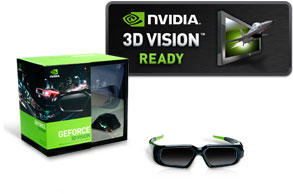 |
3D GAMING ACROSS THREE 1080P DISPLAYS, FOR A BREATHTAKING GAMING EXPERIENCE. > 3D gaming across three 1080p displays, for a breathtaking gaming experience. > Advanced NVIDIA software automatically converts over 425 games to stereoscopic 3D without the need for special game patches. > GeForce GTX 400 GPUs deliver the graphics horsepower to drive 750M pixels/second for screen 3 times Full HD 1080p 3D Vision gaming for an incredible 5760×1080 experience. > Compatible with all 3D Vision-Ready desktop monitors and projectors. |
| GET UP AND GAMING IN MINUTES WITH THE WORLD’S MOST ADVANCED MULTI-DISPLAY SOFTWARE. > Works with all standard monitor connectors, without requiring special display adapter dongles. > Simple to use setup wizard guides users through setup and allows bezel correction to enable a seamless display experience. > Advanced GPU synchronization ensures seamless support and maximum framerate > Use Accessory Displays to watch movies, browse the web, or chat with friends. |
 |
NVIDIA PureVideo Technology
NVIDIA® PureVideo® technology brings movies to life. PureVideo uses advanced techniques found only on very high-end consumer players and TVs to make Blu-ray, HD DVD, standard-definition DVD movies, PC and mobile device content look crisp, clear, smooth and vibrant. Regardless of whether you’re watching on an LCD monitor or a plasma TV, with PureVideo the picture will always be precise, vivid and lifelike.
PureVideo is included on the processing cores on NVIDIA GPUs and handheld devices for the decoding and playback of video. If your PC is equipped with one of these GPUs, you can take advantage of PureVideo and PureVideo HD. NVIDIA applications processors also leverage this technology to deliver top class video quality to mobile devices.
 |
NVIDIA PureVideo HD
Available on select NVIDIA® GeForce® 7,8, and 9 series and NVIDIA Quadro® GPUs, PureVideo HD is a superset of the PureVideo functionality that is essential for the ultimate
Blu-ray and HD DVD movie experience on a Desktop PC or notebook computer. Learn More
 |
NVIDIA PureVideo
Available on most NVIDIA GeForce, NVIDIA APX applications processors and NVIDIA Quadro GPUs, PureVideo is for playback of standard-definition DVDs, PC video and mobile content. Learn More
What is CUDA?
CUDA is NVIDIA’s parallel computing architecture that enables dramatic increases in computing performance by harnessing the power of the GPU (graphics processing unit).
With millions of CUDA-enabled GPUs sold to date, software developers, scientists and researchers are finding broad-ranging uses for CUDA, including image and video processing, computational biology and chemistry, fluid dynamics simulation, CT image reconstruction, seismic analysis, ray tracing and much more.
Computing is evolving from “central processing” on the CPU to “co-processing” on the CPU and GPU. To enable this new computing paradigm, NVIDIA invented the CUDA parallel computing architecture that is now shipping in GeForce, ION, Quadro, and Tesla GPUs, representing a significant installed base for application developers.
In the consumer market, nearly every major consumer video application has been, or will soon be, accelerated by CUDA, including products from Elemental Technologies, MotionDSP and LoiLo, Inc.
CUDA has been enthusiastically received in the area of scientific research. For example, CUDA now accelerates AMBER, a molecular dynamics simulation program used by more than 60,000 researchers in academia and pharmaceutical companies worldwide to accelerate new drug discovery.
In the financial market, Numerix and CompatibL announced CUDA support for a new counterparty risk application and achieved an 18X speedup. Numerix is used by nearly 400 financial institutions.
An indicator of CUDA adoption is the ramp of the Tesla GPU for GPU computing. There are now more than 700 GPU clusters installed around the world at Fortune 500 companies ranging from Schlumberger and Chevron in the energy sector to BNP Paribas in banking.
And with the recent launches of Microsoft Windows 7 and Apple Snow Leopard, GPU computing is going mainstream. In these new operating systems, the GPU will not only be the graphics processor, but also a general purpose parallel processor accessible to any application.
For information on CUDA and OpenCL, click here.
For information on CUDA and DirectX, click here.
For information on CUDA and Fortran, click here.
PhysX
Some Games that use PhysX (Not all inclusive)
 |
Batman: Arkham Asylum Watch Arkham Asylum come to life with NVIDIA® PhysX™ technology! You’ll experience ultra-realistic effects such as pillars, tile, and statues that dynamically destruct with visual explosiveness. Debris and paper react to the environment and the force created as characters battle each other; smoke and fog will react and flow naturally to character movement. Immerse yourself in the realism of Batman Arkham Asylum with NVIDIA PhysX technology. |
 |
Darkest of Days Darkest of Days is a historically based FPS where gamers will travel back and forth through time to experience history’s “darkest days”. The player uses period and future weapons as they fight their way through some of the epic battles in history. The time travel aspects of the game, lead the player on missions where they at times need to fight on both sides of a war. |
 |
Sacred 2 – Fallen Angel In Sacred 2 – Fallen Angel, you assume the role of a character and delve into a thrilling story full of side quests and secrets that you will have to unravel. Breathtaking combat arts and sophisticated spells are waiting to be learned. A multitude of weapons and items will be available, and you will choose which of your character’s attributes you will enhance with these items in order to create a unique and distinct hero. |
 |
Dark Void Dark Void is a sci-fi action-adventure game that combines an adrenaline-fuelled blend of aerial and ground-pounding combat. Set in a parallel universe called “The Void,” players take on the role of Will, a pilot dropped into incredible circumstances within the mysterious Void. This unlikely hero soon finds himself swept into a desperate struggle for survival. |
 |
Cryostasis Cryostasis puts you in 1968 at the Arctic Circle, Russian North Pole. The main character, Alexander Nesterov is a meteorologist incidentally caught inside an old nuclear ice-breaker North Wind, frozen in the ice desert for decades. Nesterov’s mission is to investigate the mystery of the ship’s captain death – or, as it may well be, a murder. |
 |
Mirror’s Edge In a city where information is heavily monitored, agile couriers called Runners transport sensitive data away from prying eyes. In this seemingly utopian paradise of Mirror’s Edge, a crime has been committed and now you are being hunted. |
What is NVIDIA PhysX Technology?
NVIDIA® PhysX® is a powerful physics engine enabling real-time physics in leading edge PC games. PhysX software is widely adopted by over 150 games and is used by more than 10,000 developers. PhysX is optimized for hardware acceleration by massively parallel processors. GeForce GPUs with PhysX provide an exponential increase in physics processing power taking gaming physics to the next level.
What is physics for gaming and why is it important?
Physics is the next big thing in gaming. It’s all about how objects in your game move, interact, and react to the environment around them. Without physics in many of today’s games, objects just don’t seem to act the way you’d want or expect them to in real life. Currently, most of the action is limited to pre-scripted or ‘canned’ animations triggered by in-game events like a gunshot striking a wall. Even the most powerful weapons can leave little more than a smudge on the thinnest of walls; and every opponent you take out, falls in the same pre-determined fashion. Players are left with a game that looks fine, but is missing the sense of realism necessary to make the experience truly immersive.
With NVIDIA PhysX technology, game worlds literally come to life: walls can be torn down, glass can be shattered, trees bend in the wind, and water flows with body and force. NVIDIA GeForce GPUs with PhysX deliver the computing horsepower necessary to enable true, advanced physics in the next generation of game titles making canned animation effects a thing of the past.
Which NVIDIA GeForce GPUs support PhysX?
The minimum requirement to support GPU-accelerated PhysX is a GeForce 8-series or later GPU with a minimum of 32 cores and a minimum of 256MB dedicated graphics memory. However, each PhysX application has its own GPU and memory recommendations. In general, 512MB of graphics memory is recommended unless you have a GPU that is dedicated to PhysX.
How does PhysX work with SLI and multi-GPU configurations?
When two, three, or four matched GPUs are working in SLI, PhysX runs on one GPU, while graphics rendering runs on all GPUs. The NVIDIA drivers optimize the available resources across all GPUs to balance PhysX computation and graphics rendering. Therefore users can expect much higher frame rates and a better overall experience with SLI.
A new configuration that’s now possible with PhysX is 2 non-matched (heterogeneous) GPUs. In this configuration, one GPU renders graphics (typically the more powerful GPU) while the second GPU is completely dedicated to PhysX. By offloading PhysX to a dedicated GPU, users will experience smoother gaming.
Finally we can put the above two configurations all into 1 PC! This would be SLI plus a dedicated PhysX GPU. Similarly to the 2 heterogeneous GPU case, graphics rendering takes place in the GPUs now connected in SLI while the non-matched GPU is dedicated to PhysX computation.
Why is a GPU good for physics processing?
The multithreaded PhysX engine was designed specifically for hardware acceleration in massively parallel environments. GPUs are the natural place to compute physics calculations because, like graphics, physics processing is driven by thousands of parallel computations. Today, NVIDIA’s GPUs, have as many as 480 cores, so they are well-suited to take advantage of PhysX software. NVIDIA is committed to making the gaming experience exciting, dynamic, and vivid. The combination of graphics and physics impacts the way a virtual world looks and behaves.
Direct Compute
DirectCompute Support on NVIDIA’s CUDA Architecture GPUs
Microsoft’s DirectCompute is a new GPU Computing API that runs on NVIDIA’s current CUDA architecture under both Windows VISTA and Windows 7. DirectCompute is supported on current DX10 class GPU’s and DX11 GPU’s. It allows developers to harness the massive parallel computing power of NVIDIA GPU’s to create compelling computing applications in consumer and professional markets.
As part of the DirectCompute presentation at the Game Developer Conference (GDC) in March 2009 in San Francisco CA, NVIDIA demonstrated three demonstrations running on a NVIDIA GeForce GTX 280 GPU that is currently available. (see links below)
As a processor company, NVIDIA enthusiastically supports all languages and API’s that enable developers to access the parallel processing power of the GPU. In addition to DirectCompute and NVIDIA’s CUDA C extensions, there are other programming models available including OpenCL™. A Fortran language solution is also in development and is available in early access from The Portland Group.
NVIDIA has a long history of embracing and supporting standards since a wider choice of languages improve the number and scope of applications that can exploit parallel computing on the GPU. With C and Fortran language support here today and OpenCL and DirectCompute available this year, GPU Computing is now mainstream. NVIDIA is the only processor company to offer this breadth of development environments for the GPU.
OpenCL
| OpenCL (Open Computing Language) is a new cross-vendor standard for heterogeneous computing that runs on the CUDA architecture. Using OpenCL, developers will be able to harness the massive parallel computing power of NVIDIA GPU’s to create compelling computing applications. As the OpenCL standard matures and is supported on processors from other vendors, NVIDIA will continue to provide the drivers, tools and training resources developers need to create GPU accelerated applications.
In partnership with NVIDIA, OpenCL was submitted to the Khronos Group by Apple in the summer of 2008 with the goal of forging a cross platform environment for general purpose computing on GPUs. NVIDIA has chaired the industry working group that defines the OpenCL standard since its inception and shipped the world’s first conformant GPU implementation for both Windows and Linux in June 2009. |
 |
NVIDIA has been delivering OpenCL support in end-user production drivers since October 2009, supporting OpenCL on all 180,000,000+ CUDA architecture GPUs shipped since 2006.
NVIDIA’s Industry-leading support for OpenCL:
2010
March – NVIDIA releases updated R195 drivers with the Khronos-approved ICD, enabling applications to use OpenCL NVIDIA GPUs and other processors at the same time
January – NVIDIA releases updated R195 drivers, supporting developer-requested OpenCL extensions for Direct3D9/10/11 buffer sharing and loop unrolling
January – Khronos Group ratifies the ICD specification contributed by NVIDIA, enabling applications to use multiple OpenCL implementations concurrently
2009
November – NVIDIA releases R195 drivers with support for optional features in the OpenCL v1.0 specification such as double precision math operations and OpenGL buffer sharing
October – NVIDIA hosts the GPU Technology Conference, providing OpenCL training for an additional 500+ developers
September – NVIDIA completes OpenCL training for over 1000 developers via free webinars
September – NVIDIA begins shipping OpenCL 1.0 conformant support in all end user (public) driver packages for Windows and Linux
September – NVIDIA releases the OpenCL Visual Profiler, the industry’s first hardware performance profiling tool for OpenCL applications
July – NVIDIA hosts first “Introduction to GPU Computing and OpenCL” and “Best Practices for OpenCL Programming, Advanced” webinars for developers
July – NVIDIA releases the NVIDIA OpenCL Best Practices Guide, packed with optimization techniques and guidelines for achieving fast, accurate results with OpenCL
July – NVIDIA contributes source code and specification for an Installable Client Driver (ICD) to the Khronos OpenCL Working Group, with the goal of enabling applications to use multiple OpenCL implementations concurrently on GPUs, CPUs and other types of processors
June – NVIDIA release first industry first OpenCL 1.0 conformant drivers and developer SDK
April – NVIDIA releases industry first OpenCL 1.0 GPU drivers for Windows and Linux, accompanied by the 100+ page NVIDIA OpenCL Programming Guide, an OpenCL JumpStart Guide showing developers how to port existing code from CUDA C to OpenCL, and OpenCL developer forums
2008
December – NVIDIA shows off the world’s first OpenCL GPU demonstration, running on an NVIDIA laptop GPU at
June – Apple submits OpenCL proposal to Khronos Group; NVIDIA volunteers to chair the OpenCL Working Group is formed
2007
December – NVIDIA Tesla product wins PC Magazine Technical Excellence Award
June – NVIDIA launches first Tesla C870, the first GPU designed for High Performance Computing
May – NVIDIA releases first CUDA architecture GPUs capable of running OpenCL in laptops & workstations
2006
November – NVIDIA released first CUDA architecture GPU capable of running OpenCL
Pictures & Impressions
The overall schematics of the card did not change significantly in comparison to Palit GTX 460. The card still requires 2x 6-pin power cables, since the power consumption of GTX 560 Ti did not go up significantly enough to require more power. Like the GTX 460, Palit GTX 560 Ti Sonic is able to support 2-way SLI. The video outputs consist of 2 DVI, 1 VGA and a single HDMI. An additional VGA port in comparison to the competition is a nice addition to this card, as it makes the card compatible with older monitors without the need for an adapter.
While the basic schematics did not change significantly, there is a difference in the quantity and placement of capacitors. Palit GTX 560 Ti Sonic has 11 capacitors, unlike its predecessor, which only had 10. The majority of the changes in schematics were made to allow the card to run at a higher voltage. The voltage used to stablilize this card is significantly lower than its competition, and at 900 MHz, the GPU clock is only .975 V. Since the Palit GTX 560 Ti runs on lower voltage and therefore has lower temperatures, no modifications to the heatsink are observed. The basic structure of heatsink is very similar to the reference card. However, it is hard to predict whether modifications would benefit this card significantly.
Testing & Methodology
The OS we use is Windows 7 Pro 64bit with all patches and updates applied. We also use the latest drivers available for the motherboard and any devices attached to the computer. We do not disable background tasks or tweak the OS or system in any way. We turn off drive indexing and daily defragging. We also turn off Prefetch and Superfetch. This is not an attempt to produce bigger benchmark numbers. Drive indexing and defragging can interfere with testing and produce confusing numbers. If a test were to be run while a drive was being indexed or defragged, and then the same test was later run when these processes were off, the two results would be contradictory and erroneous. As we cannot control when defragging and indexing occur precisely enough to guarantee that they won’t interfere with testing, we opt to disable the features entirely.
Prefetch tries to predict what users will load the next time they boot the machine by caching the relevant files and storing them for later use. We want to learn how the program runs without any of the files being cached, and we disable it so that each test run we do not have to clear pre-fetch to get accurate numbers. Lastly we disable Superfetch. Superfetch loads often-used programs into the memory. It is one of the reasons that Windows Vista occupies so much memory. Vista fills the memory in an attempt to predict what users will load. Having one test run with files cached, and another test run with the files un-cached would result in inaccurate numbers. Again, since we can’t control its timings so precisely, it we turn it off. Because these four features can potentially interfere with benchmarking, and and are out of our control, we disable them. We do not disable anything else.
We ran each test a total of 3 times, and reported the average score from all three scores. Benchmark screenshots are of the median result. Anomalous results were discounted and the benchmarks were rerun.
Please note that due to new driver releases with performance improvements, we rebenched every card shown in the results section. The results here will be different than previous reviews due to the performance increases in drivers.
|
Test Rig |
|
| Case | In-Win Dragon Rider |
| CPU |
Intel Core i7 930 @ 3.8GHz |
| Motherboard |
ASUS Rampage III Extreme ROG – LGA1366 |
| RAM |
3x 2GB Corsair 1333MHz |
| CPU Cooler | Thermalright True Black 120 with 2x Noctua NF-P12 Fans |
| Drives |
3x Seagate Barracuda 1TB 7200.12 Drives |
| Optical | ASUS DVD-Burner |
| GPU |
Nvidia GeForce GTX 560 Ti Palit GTX 560 Ti Sonic ASUS ENGTX 560 Ti ASUS ENGTX580 1536MB Nvidia GeForce GTX 580 1536MB Nvidia GeForce GTX 570 1536MB Galaxy GeForce GTX 480 1536MB Palit GeForce GTX 460 Sonic Platinum 1GB in SLI ASUS Radeon HD6870 AMD Radeon HD5870 |
| Case Fans |
3x Noctua NF-P12 Fans – Side 3x In-Win 120mm Fans – Front, Back, Top |
| Additional Cards |
Ineo I-NPC01 2 Ports PCI-Express Adapter for USB 3.0 |
| PSU |
SeaSonic X750 Gold 750W |
| Mouse | Logitech G5 |
| Keyboard | Thermaltake Meka G1 |
Synthetic Benchmarks & Games
We will use the following applications to benchmark the performance of the Nvidia GeForce GTX 560 Ti video card.
| Synthetic Benchmarks & Games | |
| 3DMark Vantage | |
| Metro 2033 | |
| Stone Giant | |
| Unigine Heaven v.2.1 | |
| Crysis | |
| Crysis Warhead | |
| HAWX 2 | |
Methodology
In order to provide an objective testing for the Palit GTX 560 Ti Sonic, several testing parameters were taken into consideration. The Palit GTX 560 Ti Sonic ran through a set of benchmarks that utilize DX10 and DX11 in order to analyze the tessellation capabilities of this card, while real life game testing was used to estimate the performance that an average gamer would see during games such as Crysis and Metro 2033. Due to the Palit GTX 560 Ti Sonic’s excellent overclocking ability, the GPU was tested at both 900 MHz and 1 GHz clocks. In addition, the Palit GTX 560 Ti Sonic was coupled with an ASUS ENGTX 560 Ti DirectCU II TOP in 2-way SLI and placed on the top PCI-E slot in order to see the extent of its cooling capability. The final factor assessed in this review was the power consumption of the card in order to confirm the overall efficiency.
Unigine Heaven 2.1
Unigine Heaven is a benchmark program based on Unigine Corp’s latest engine, Unigine. The engine features DirectX 11, Hardware tessellation, DirectCompute, and Shader Model 5.0. All of these new technologies combined with the ability to run each card through the same exact test means this benchmark should be in our arsenal for a long time.
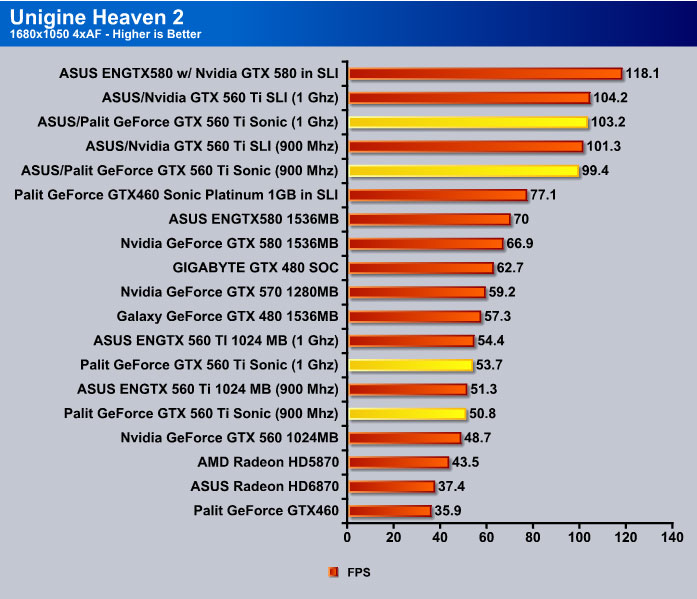
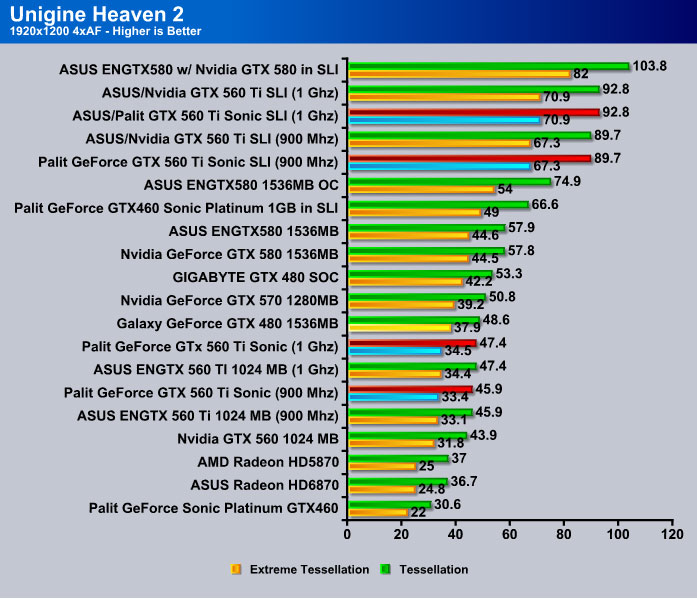
Unigine Heaven 2, unlike Crysis and Crysis Warhead, allows for a completely different test of performance. Since Unigine is a newer benchmark that fully utilizes DirectX 11, it is a more objective test in order to assess true performance of Palit GTX 560 Ti Sonic on the latest games. As the result of testing we can clearly see that GTX 560 Ti Sonic is able to provide a sufficient FPS for smooth play even with the use of extreme tesselation. At the same time Palit GTX 560 Ti is able to leave the ATI competition completely in the dust and rival the performance of the GTX 480 even more closely than observed in DirectX 10. In fact, the Palit GTX 560 Ti Sonic overclocked at 1 GHz lands within the range of 1 FPS of the 480, making them practically equal.
We used a 60 second Fraps run and recorded the Min/Avg/Max FPS rather than rely on the built in utility for determining FPS. We started the benchmark, triggered Fraps and let it run on stock settings for 60 seconds without making any adjustments of changing camera angles. We just let it run at default and had Fraps record the FPS and log them to a file for us.
Key features of the BitSquid Tech (PC version) include:
- Highly parallel, data oriented design
- Support for all new DX11 GPUs, including the NVIDIA GeForce GTX 400 Series and AMD Radeon 5000 series
- Compute Shader 5 based depth of field effects
- Dynamic level of detail through displacement map tessellation
- Stereoscopic 3D support for NVIDIA 3dVision
“With advanced tessellation scenes, and high levels of geometry, Stone Giant will allow consumers to test the DX11-credentials of their new graphics cards,” said Tobias Persson, Founder and Senior Graphics Architect at BitSquid. “We believe that the great image fidelity seen in Stone Giant, made possible by the advanced features of DirectX 11, is something that we will come to expect in future games.”
“At Fatshark, we have been creating the art content seen in Stone Giant,” said Martin Wahlund, CEO of Fatshark. “It has been amazing to work with a bleeding edge engine, without the usual geometric limitations seen in current games”.
Stone Giant demonstrates a slightly different results in comparison to Unigine. While the increase is not as drastic, there is still a solid 21% improvement at 1680×1050. In comparison to DirectX 10 benchmarks, DirectX 11 tessellation provides significantly better results. The overclocked Palit GTX 560 Ti Sonic lands within 1 FPS of the Galaxy GeForce GTX 480 yet again, demonstrating the devastating performance increase that this is card is capable of when overclocked.
3DMark Vantage
For complete information on 3DMark Vantage Please follow this Link:
www.futuremark.com/benchmarks/3dmarkvantage/features/
The newest video benchmark from the gang at Futuremark. This utility is still a synthetic benchmark, but one that more closely reflects real world gaming performance. While it is not a perfect replacement for actual game benchmarks, it has its uses. We tested our cards at the ‘Performance’ setting.

After running 3DMark Vantage the result confirms the overall increase of 44% in the performance of Palit GTX 560 Sonic Platinum in comparison to its predecessor. The overall GPU score lands within 1000 points away of the Galaxy GeForce GTX 480, suggesting that the Palit GTX 560 Ti is capable of delivering performance rivaling a $400 card. The SLI performance of the Palit GTX 560 Ti Sonic shows a score 31330, which is significantly faster than a single overclocked 580. This demonstrates that Palit GTX 560 Ti Sonic in SLI provides excellent performance for a fairly low value. For those that can not afford to purchase a GTX 580, the Palit GTX 560 Ti Sonic could prove to be an excellent choice.
Crysis v. 1.21
Crysis is the most highly anticipated game to hit the market in the last several years. Crysis is based on the CryENGINE™ 2 developed by Crytek. The CryENGINE™ 2 offers real time editing, bump mapping, dynamic lights, network system, integrated physics system, shaders, shadows, and a dynamic music system, just to name a few of the state-of-the-art features that are incorporated into Crysis. As one might expect with this number of features, the game is extremely demanding of system resources, especially the GPU. We expect Crysis will soon be replaced by its sequel, the DX11 compatible Crysis 2.
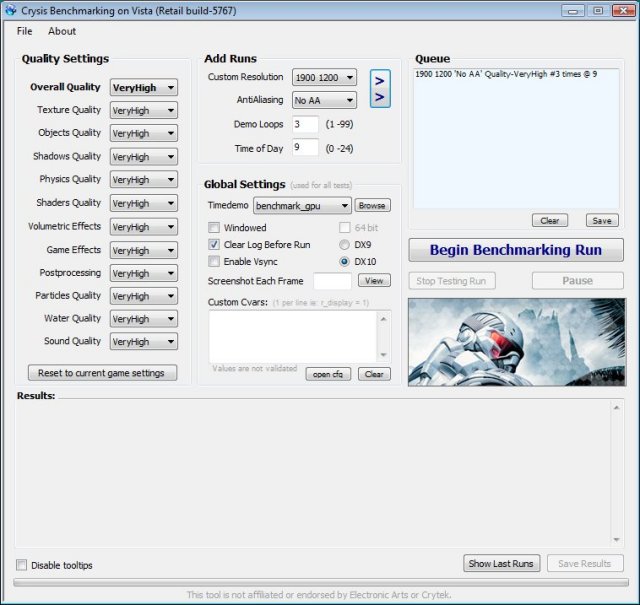

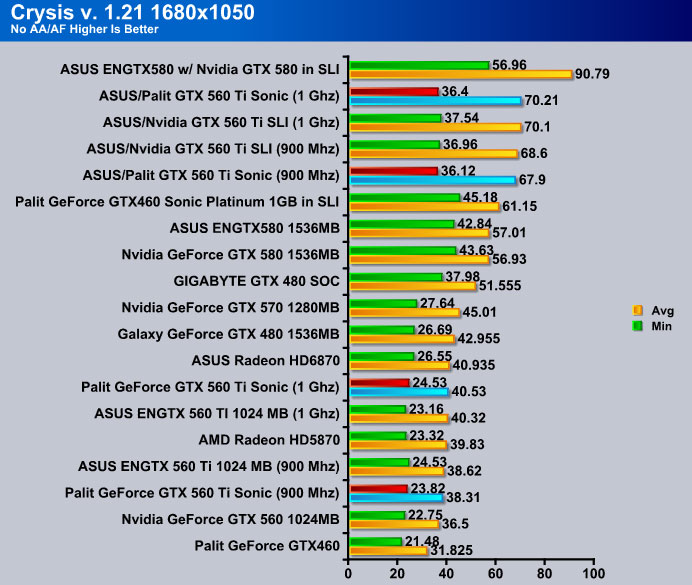
Results observed at the higher resolution demonstrate an improvement of performance of Palit GTX 560 Ti Sonic in comparison to the AMD competition. The outstanding performance lands within 2-3 fps from Galaxy GeForce GTX 480, yet again confirming the worth of this card.
CRYSIS WARHEAD
Crysis Warhead is the much anticipated standalone expansion to Crysis, featuring an updated CryENGINE™ 2 with better optimization. It was one of the most anticipated titles of 2008.

Warhead results are similar to those observed in Crysis, and show that the Palit GTX 560 Ti Sonic delivers outstanding performance, rivaling the GTX 480. In comparison to the Palit GTX 460 Ti Sonic Platinum, there is a 45% increase at 1680×1050 2xAA, and a 50% performance increase with AA disabled. This clearly shows that the GF114 GPU is superior to the GF104.
While the reference GTX 560 Ti offers an increase of 5-10 FPS over the Palit GTX 460 Sonic Platinum, the Palit GTX 560 Ti Sonic overclocked at 1 GHz demonstrates a solid 9 FPS increase, which is a roughly 10% increase over its predecessor.
The overall performance in DirectX 10 benchmarks makes the Palit GTX 560 Ti an excellent choice for any gamer. This low budget high-end card is able to deliver outstanding performance for a fair price that easily competes with $300-400 cards.
Metro 2033
Metro 2033 is an action-oriented video game blending survival horror and first-person shooter elements. The game is based on the novel Metro 2033 by Russian author Dmitry Glukhovsky. It was developed by 4A Games in Ukraine and released in March 2010 for the Xbox 360 and Microsoft Windows. In March 2009, 4A Games announced a partnership with Glukhovsky to collaborate on the game. The game was announced a few months later at the 2009 Games Convention in Leipzig; a first trailer came along with the announcement. When the game was announced, it had the subtitle “The Last Refuge,” but this subtitle is no longer being used.
We left Metro 2033 on all high settings with Depth of Field on.
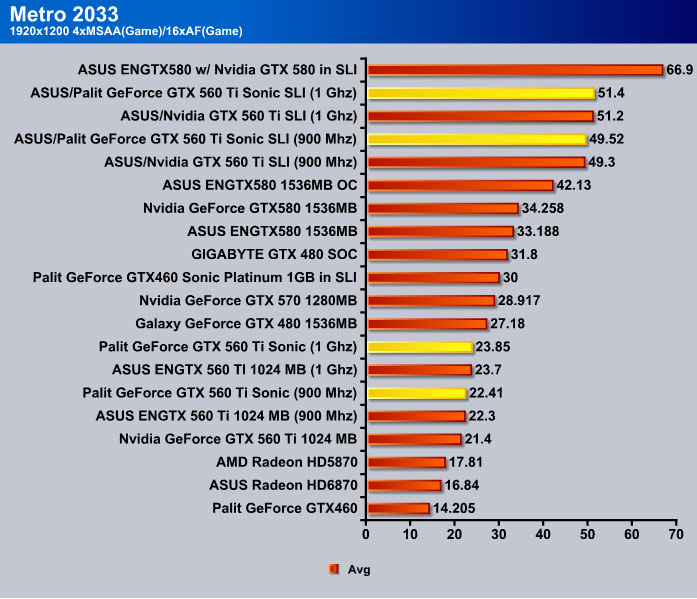
Metro 2033 is a perfect game to test the average gaming performance of the Palit GTX 560 Ti Sonic. With DirectX 11 and intense antialiasing for the volumetric fog, this game requires a very high-powered system in order to run smoothly. Overall, a lower resolution brings a smoother gaming experience, but the game is still playable at 1900×1200. The primary problems associated with playing at higher resolution is the presence of the fog on the surface levels, which can bring the FPS down to 16. However in the game’s underground, there is no problem getting a solid 22-24 FPS, sufficient enough to make this game playable. In comparison to its predecessor Palit GTX 460 Sonic Platinum, it is a drastic improvement in performance and definetely is the optimal choice for any gamer with low budget.
HAWX 2
Tom Clancy’s H.A.W.X. 2 plunges fans into an explosive environment where they can become elite aerial soldiers in control of the world’s most technologically advanced aircraft. The game will appeal to a wide array of gamers as players will have the chance to control exceptional pilots trained to use cutting edge technology in amazing aerial warfare missions.
Developed by Ubisoft, H.A.W.X. 2 challenges you to become an elite aerial soldier in control of the world’s most technologically advanced aircraft. The aerial warfare missions enable you to take to the skies using cutting edge technology.
HAWX 2 results appear to be slightly inconsitent, but this error is to be expected considering the high FPS achieved on this benchmark. While there is a 6 FPS difference between Nvidia GTX 560 Ti and Palit GTX 560 Ti Sonic under lower resolution, the higher resolution knocks the difference away. Overall, the performance increase in comparison to Palit GTX 460 Sonic Platinum is not as drastic and is calculated to be roughly 7-12%.
TEMPERATURES
To measure the temperature of the video card, we used MSI Afterburner and ran Metro 2033 for 10 minutes to find the Load temperatures for the video cards. The highest temperature was recorded. After playing for 10 minutes, Metro 2033 was turned off and we let the computer sit at the desktop for another 10 minutes before we measured the idle temperatures.
| Video Cards – Temperatures – Ambient 23C | Idle | Load (Fan Speed) |
|---|---|---|
| 2x Palit GTX 460 Sonic Platinum 1GB GDDR5 in SLI |
31C |
65C |
| Nvidia GTX 560 Ti | 30 C | 64 C |
| Palit GTX 460 Sonic Platinum 1GB GDDR5 |
29C |
60C |
| Galaxy GTX 480 |
53C |
81C (73%) |
| Nvidia GeForce GTX 580 | 39C | 73C (66%) |
| ASUS ENGTX 560 Ti Direct CU II TOP (900 Mhz) | 33 | 62 |
| ASUS ENGTX 560 Ti Direct CU II TOP (1 Ghz) | 35 | 64 |
| ASUS ENGTX 560 Ti Direct CU II TOP SLI (900 Mhz) | 36 | 68 |
| ASUS ENGTX 560 Ti Direct CU II TOP SLI (1 Ghz) | 39 | 73 |
| Palit GTX 560 Ti Sonic (900 Mhz) | 36 | 67 |
| Palit GTX 560 Ti Sonic (1 Ghz) | 37 | 70 |
|
Palit GTX 560 Ti Sonic SLI (900 Mhz) |
40 | 72 |
| Palit GTX 560 Ti Sonic SLI (1 Ghz) | 43 | 76 |
In comparison to the Nvidia reference card, the Palit GTX 560 Ti Sonic demonstrates better cooling capabilities. While the Nvidia reference card is equiped with only a single fan, the Palit GTX 560 Ti Sonic carries 2x 80mm fans. However, the card does run hotter than the ASUS ENGTX 560 Ti DirectCU II. This could explained due to the lack of modifications to the heat sink of Palit GTX 560 Ti Sonic. The overall structure of the heat sink is rather simple. Since the heat sink is only adjacent to the GPU, most of the heat dissipation occurs through air, leaving the rest of the graphics card components rather hot.
POWER CONSUMPTION
To get our power consumption numbers, we plugged in our Kill A Watt power measurement device and took the Idle reading at the desktop during our temperature readings. We left it at the desktop for about 15 minutes and took the idle reading. Then we ran Metro 2033 for a few minutes minutes and recorded the highest power usage.
| Video Cards – Power Consumption | Idle | Load |
|---|---|---|
| 2x Palit GTX 460 Sonic Platinum 1GB GDDR5 in SLI |
315W |
525W |
| Palit GTX 460 Sonic Platinum 1GB GDDR5 |
249W |
408W |
| Nvidia GTX 460 1GB |
237W |
379W |
| Galaxy GTX 480 |
248W |
439W |
| Nvidia GTX 560 TI 1GB | 260 W | 412 W |
|
ASUS ENGTX 560 Ti DirectCU II TOP (900 Mhz) |
262 W | 423 W |
|
ASUS ENGTX 560 Ti DirectCU II TOP (1 Ghz) |
264 W | 436 W |
| ASUS ENGTX 560 Ti DirectCU II TOP SLI (900 Mhz) | 279W | 534 W |
| ASUS ENGTX 560 Ti DirectCU II TOP SLI(1 Ghz) | 284W | 542W |
|
Palit GTX 560 Ti Sonic (900 Mhz) |
259W | 421W |
| Palit GTX 560 Ti Sonic (1 Ghz) | 264W | 436W |
| Palit GTX 560 Ti Sonic SLI (900 Mhz) | 276W | 435W |
| Palit GTX 560 Ti Sonic SLI (1 Ghz) | 283W | 540W |
While the overall cooling performance of Palit GTX 560 Ti Sonic was not impressive, the power consumption in comparison to ASUS ENGTX 560 Ti Direct CU II is actually lower. During overclocking it was noted that the Palit GTX 560 Ti Sonic required a significantly lower voltage in comparison to its competition. While power consumption is not significantly different, this card has the best performance/watt out of all GTX 560 Ti vendor cards.
Conclusion
The Palit GTX 560 Ti Sonic demonstrates excellent performance while retaining unique traits of Palit graphics cards. The Palit GTX 560 is designed to fit into any mid tower case, making this card accessible for any gaming system. At a price of 249.99 USD for the reference GTX 560 Ti (822 MHz) and 259.99 USD for Palit GTX 560 Ti Sonic (900 MHz), this product is an excellent choice for any gamer looking for an affordable card.
The Palit GTX 560 Ti Sonic demonstrates an overall 30% performance increase in comparison to the Palit GTX 460 Ti Sonic Platinum. In comparison to the 900 MHz ASUS ENGTX 560 Ti DirectCU II, the performance is almost identical. Considering that there is a $10 difference in price, the Palit GTX 560 Ti Sonic is an ideal choice for anyone that is looking for a low budget high-end performance card. Another important advantage of Palit GTX 560 Ti Sonic is its compact and light structure, allowing the card to fit into the smallest cases.
While Palit GTX 560 Ti Sonic poses a serious competition to other distributors like ASUS or MSI, there are several cons that must be noted. While Palit’s card is able to deliver devastating performance equal to the ASUS ENGTX 560 DirectCU II, the cooling performance was not nearly as impressive. Although the Palit GTX 560 Ti Sonic was equiped with 2x 80mm fans that provided a significantly better cooling than the Nvidia reference card, the heat sink was no match to the ASUS ENGTX 560 Ti. The Palit GTX 560 Ti had no cooling for the memory chips, as well as no cooling for the VRM. In addition, the software and auxillary items were rather basic. While it is not a requirement to include fancy gadgets or software, the packaged bundles are often just as valuable as the performance.
| OUR VERDICT: Palit GTX 560 Ti Sonic | ||||||||||||||||||
|
||||||||||||||||||
| Summary: The Palit GTX 560 Ti Sonic delivers great performance worthy of its price. It is an ideal graphics card for any gaming enthusiast that is looking for a great gaming experience. With 8.75/10, the Palit GTX 560 Ti Sonic earns the Bjorn3D Best Bang For The Buck, and the Bjorn3D Silver Bear Award. |
 Bjorn3D.com Bjorn3d.com – Satisfying Your Daily Tech Cravings Since 1996
Bjorn3D.com Bjorn3d.com – Satisfying Your Daily Tech Cravings Since 1996

